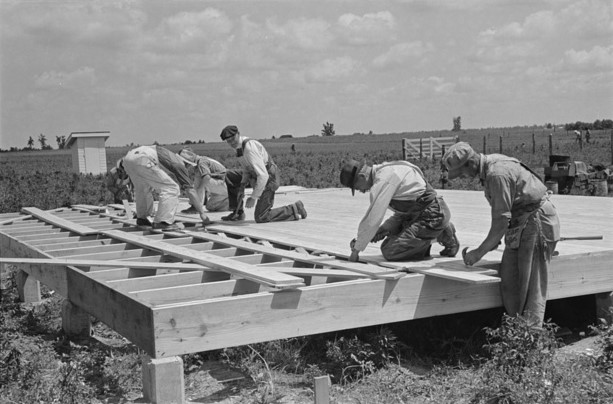Subfloor

|
| Workers instal a subfloor for a home being built as part of the Southeast Missouri Farms Project, 1938. |
Contents |
[edit] Introduction
The subfloor is the initial layer of solid material placed just above the joists or other structure of a building.
Some structures may have solid hardwood flooring that is attached directly to the joists. This surface essentially serves as the subfloor.
Others may have a solid concrete foundation that serves as the subfloor. Concrete slabs that form the ground floor of a building may be either supported on beams (called a suspended slab) or supported directly on the subsoil (via hardcore, for example) called a ‘ground-bearing slab'.
Additional structure is sometimes installed over concrete slab subfloors in order to provide a level foundation that’s suitable for the installation of underlayment and flooring. This type of structure may be used when bearing conditions require it or groundwater is present.
Placing a solid subfloor over the joists, covering it with underlayment and then layering that with flooring provides a more stable surface. It also helps to assure that the joists support most of the load of the floor.
[edit] Types of subfloor
Plywood is the most common material used for subfloors. Plywood has several properties that make it a useful and popularfor this purpose, including:
- High strength.
- High panel shear.
- Flexibility.
- Moisture resistance.
- Chemical and fire resistance.
- Impact resistance.
- Insulation.
The thickness of a plywood subfloor depends on the distance between joists. Thinner plywood can be used when joists are close together, but slightly thicker plywood is recommended when there is more than 40cm between joists.
Subfloors can also be made from oriented strand board (OSB). OSB has similar properties to plywood and is suitable for load-bearing applications. It can be more cost-effective than plywood. Impermeability to water can be achieved through the use of additional membranes.
Another type of subfloor is high-performance engineered panels. Like plywood and OSB, these panels are designed for load bearing applications. They have built in moisture resistance and are manufactured with special resins to reduce other issues - such as swelling - associated with some subfloors.
[edit] Problems with subfloors
Issues with subfloors can arise due to problems with installation, use of unsuitable materials or damage caused by dampness. These problems can be minor (resulting in squeaking or sagging) or they can be major (resulting in significant movement or total failure).
Moisture is one of the most common problems associated with subfloors. Signs of subfloor moisture problems include:
- Sunken sections.
- Squeaking.
- Smelling damp.
- Shifting or bouncing floors.
- Rocking or loose fixtures and fittings.
- Cracking tile flooring.
- Dipping or buldging.
- Bubbling linoleum floor.
A vapour or moisture barrier installed over the subfloor can sometimes help to reduce seasonal fluctuations brought about by changes in humidity and heat, but serious moisture issues may require more significant remediation measures including subfloor replacement.
[edit] Related articles on Designing Buildings Wiki
Featured articles and news
Social and affordable housing, a long term plan for delivery
The “Delivering a Decade of Renewal for Social and Affordable Housing” strategy sets out future path.
A change to adoptive architecture
Effects of global weather warming on architectural detailing, material choice and human interaction.
The proposed publicly owned and backed subsidiary of Homes England, to facilitate new homes.
How big is the problem and what can we do to mitigate the effects?
Overheating guidance and tools for building designers
A number of cool guides to help with the heat.
The UK's Modern Industrial Strategy: A 10 year plan
Previous consultation criticism, current key elements and general support with some persisting reservations.
Building Safety Regulator reforms
New roles, new staff and a new fast track service pave the way for a single construction regulator.
Architectural Technologist CPDs and Communications
CIAT CPD… and how you can do it!
Cooling centres and cool spaces
Managing extreme heat in cities by directing the public to places for heat stress relief and water sources.
Winter gardens: A brief history and warm variations
Extending the season with glass in different forms and terms.
Restoring Great Yarmouth's Winter Gardens
Transforming one of the least sustainable constructions imaginable.
Construction Skills Mission Board launch sector drive
Newly formed government and industry collaboration set strategy for recruiting an additional 100,000 construction workers a year.
New Architects Code comes into effect in September 2025
ARB Architects Code of Conduct and Practice available with ongoing consultation regarding guidance.
Welsh Skills Body (Medr) launches ambitious plan
The new skills body brings together funding and regulation of tertiary education and research for the devolved nation.
Paul Gandy FCIOB announced as next CIOB President
Former Tilbury Douglas CEO takes helm.
UK Infrastructure: A 10 Year Strategy. In brief with reactions
With the National Infrastructure and Service Transformation Authority (NISTA).
Ebenezer Howard: inventor of the garden city. Book review.
Airtightness Topic Guide BSRIA TG 27/2025
Explaining the basics of airtightness, what it is, why it's important, when it's required and how it's carried out.
























